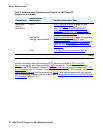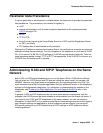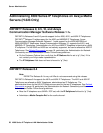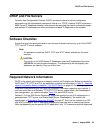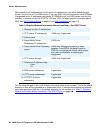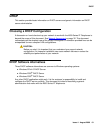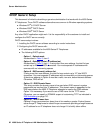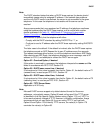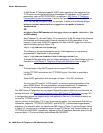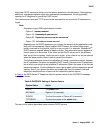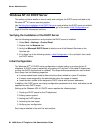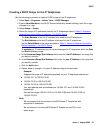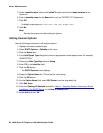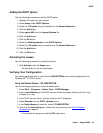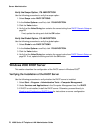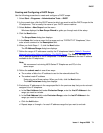
Server Administration
64 4600 Series IP Telephone LAN Administrator Guide
- A 4600 Series IP Telephone-specific DHCP option specifying information such as:
TFTP server and Avaya Media Server Gatekeeper IP addresses, or SIP-specific
parameters, such as SIPPROXYSRVR, as defined in 4600 Series IP Telephone
Customizable System Parameters. Use the Site-Specific Option Number (SSON) at
#176. You can set this option value, for example, to either of the following strings:
MCIPADD=xxx.xxx.xxx.xxx,MCPORT=yyyy,TFTPDIR=<path>,TFTPSRVR=
zzz.zzz.zzz.zzz
OR
MCIPADD={list of DNS names}, MCPORT=yyyy, TFTPDIR=<path>, TFTPSRVR= {list
of DNS names}
As of Release 2.4, also use Option 176 to identify the VLAN IDs used for the Ethernet
line interface and the secondary Ethernet interface for VLAN separation. In this
instance, if your voice VLAN ID is xxx and your data VLAN ID is yyy, at a minimum,
add the following string to Option 176:
L2Q=1,L2QVLAN=xxx,PHY2VLAN=yyy
The following is the recommended format for VLAN separation on dynamically
programmed IP telephones. In this example,
L2Q=1,L2QVLAN=xxx,VLANSEP=1,PHY2VLAN=yyy,PHY2PRIO=z
To enable VLAN separation, also set related parameters in the 46xxsettings.txt file, as
described in 4600 Series IP Telephone Scripts and Application Files
on page 77.
Note:
Note: The total length of the DHCP packet cannot exceed 576 bytes.
List the TFTPDIR value before the TFTPSRVR value, if the latter is specified in
the SSON.
Some DHCP applications limit the length of Option 176 to 247 characters.
You can have SIP-specific, H.323-specific, or common system parameters in the
same SSON Option. All such parameters are downloaded to all IP telephones,
but only the relevant parameters for a given telephone are acted upon.
The 4600 Series IP Telephones do not support Regular Expression Matching, and therefore, do
not use wildcards. See Administering Options for the 4600 Series IP Telephones
on page 100.
In configurations where the upgrade script and application files are in the default directory, do
not use the TFTPDIR=<path>.
You do not have to use Option 176. If you do not use this option, you must ensure that the key
information, especially TFTPSRVR, MCIPADD, and MCPORT, is administered appropriately
elsewhere. For example, when you specify the DNS server in Option 6, and the Domain Name
in Option 15, you can use the configured names “AvayaTFTPServer” and “AvayaCallServer” for
TFTPSRVR and MCIPADD, respectively. Upgrading from IP telephone Releases prior to R1.60
requires Option 176 to be minimally administered with MCIPADD.



